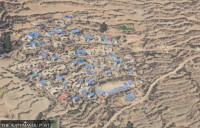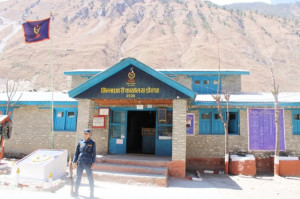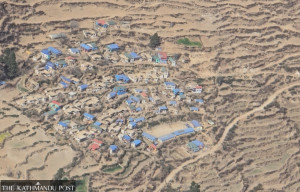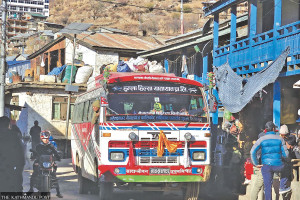Karnali Province
Daily surge in housing applicants overwhelms authorities
Many people displaced by the November 3 earthquake are still languishing in flimsy tents and huts due to delays in the distribution of housing grants.
Krishna Prasad Gautam & Harihar Singh Rathour
The consistent rise in the number of applicants seeking reconstruction grants in the districts hit by the November 3 earthquake is posing challenges for authorities in disbursing financial assistance.
In Jajarkot district, the epicentre of the earthquake, the number of earthquake victims seeking government aid has been increasing steadily. Government authorities express concerns about the difficulties they face in providing aid for the construction of temporary shelters.
On December 29, the District Administration Office made public a list of eligible beneficiaries comprising 33,045 households. But the number was revised to 35,140 by Tuesday. “Around 300-400 beneficiaries are being added to the list daily. As a result, we are having problems in the distribution of housing aid,” said Chief District Officer Suresh Sunar. “We are currently investigating the sudden rise in the number of beneficiaries before proceeding with the release of housing aid.”
The federal government, according to the Temporary Housing Construction Grant Procedure for Earthquake Affected Households-2023, provides Rs50,000 in two tranches to each displaced family whose house was completely or partially damaged and has become inhabitable.
The earthquake-displaced people are still languishing under flimsy tarpaulin tents and huts due to delays in the distribution of housing aid. The lack of proper shelter has resulted in several of the displaced falling ill in the winter cold, with reports indicating as many as 34 cold-related deaths in Jajarkot and Rukum West until the third week of last month.
“We stayed under a plastic tent for two weeks. I built a hut by using agricultural residues to keep ourselves warm. I need to construct a temporary shelter soon, but I have not received the aid yet,” said Karna Bahadur BK, aged 42. His seven-member family has been living in the thatched-roof hut. He complained that families with political connections had already received the grant and built shelters, but poor people like him were being denied government aid.
The district administration admits the delay in distributing the aid for the construction of temporary shelters is mainly due to the increasing number of applicants. The inflated numbers have given rise to doubts about accuracy of the claims.
Janak KC, a civil society leader in Jajarkot, says some families have been found to have been listed as separate families on paper to claim additional housing grants.
“A single family has been divided into two or three households now so that each family unit can claim Rs50,000 each. There could also be other reasons like political connections behind the spike in the number of beneficiaries,” he said.
According to the data available at the Karnali provincial government, there are a total of 35,140 applicants in Jajarkot while the number of applicants in Rukum West and Salyan are 23,608 and 1,730, respectively. The Internal Affairs Ministry said that a total of 6,598 houses in Jajarkot, around 4,000 houses in Rukum West and 402 houses in Salyan have been rebuilt so far. According to Krishna Bahadur Rokaya, chief of the disaster management division at the ministry, temporary shelters are yet to be constructed for around 49,000 earthquake victims.
According to Sunar, in Jajarkot, 15,309 beneficiaries have signed an agreement for the first instalment of the housing aid. Similarly, Rs 849.5 million has been disbursed for the beneficiaries in Jajarkot, out of which Rs202.8 million has been transferred into the beneficiaries’ bank accounts.
According to Hari Prasad Pant, chief district officer of West Rukum, 16,323 people have signed up for housing grants so far. Similarly, Rs840 million has been disbursed to the beneficiaries in West Rukum, and out of that, Rs590 million has been sent into the accounts of the local units. Out of the Rs590 million, the local units have transferred Rs408 million of the grant money into the accounts of beneficiaries, said Pant.
In Salyan, 580 beneficiaries have signed up for the housing grant so far and Rs70 million has been disbursed.
Man Bahadur KC, a leader of West Rukum, said that the government’s rule says that only victims who have signed an agreement for temporary shelter will get the grant money, which has created confusion in families.
“Family members are intentionally fragmenting and are busy preparing separate sets of documents in their attempt to claim separate additional grant money. The deliberate division is causing a surge in the number of applicants applying for housing grants,” said KC.
Taking into account the number of people visiting the ward offices to sign up for the grant, the number of beneficiaries could increase by at least 1,000, he said.
“Beneficiaries who have received the grant money have expedited the construction of their temporary shelters. However, the final data on beneficiaries has yet to come from some local units, so we have instructed them to work faster so the earthquake survivors can start the construction,” said Pant.
Prabhakar Sharma, principal of Suryodaya Basic School in ward 4 of Bheri Municipality in Jajarkot says that the sluggishness of the local units and district authorities in distributing grant money has left many families out in the cold.
“Some victims who lost everything, including their official government documents, have not received their grant money and are still living under tarpaulin tents in such harsh weather. Everywhere people are falling ill. The daily consumables they received in relief have depleted. No one knows how they will manage in the coming days,” he said.
Badri Pant, chair of ward 4 of Nalgad Municipality, Jajarkot, said that many earthquake victims in his ward started building temporary shelters on their own after they could not receive the first instalment of the housing grant.
“Nearly 500 houses were completely destroyed in ward 4 of the municipality. The locals have built 40 temporary shelters on their own,” said Badri.
After the earthquake, 35 people died in Jajarkot and Rukum West due to cold, diarrhoea, chronic illness, and fever.




 5.81°C Kathmandu
5.81°C Kathmandu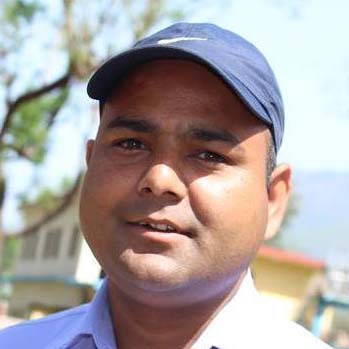
-(2).jpg)

